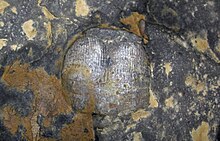Antiquatonia
| Antiquatonia Temporal range: | |
|---|---|

| |
| Fossil from the Boggs Shale | |
| Scientific classification | |
| Domain: | Eukaryota |
| Kingdom: | Animalia |
| Phylum: | Brachiopoda |
| Class: | †Strophomenata |
| Order: | †Productida |
| Family: | †Productidae |
| Tribe: | †Retariini |
| Genus: | †Antiquatonia Miloradovich, 1945 |
| Species | |
List
| |
Antiquatonia is an extinct genus of brachiopod belonging to the order Productida and family Productidae. Specimens have been found in Carboniferous beds across many continents, suggesting the genus had a cosmopolitan distribution.[1] Species level taxonomy of Antiquatonia is in need of revision.[2]
Description
Like other members of Productinae, Antiquatonia had a deep corpus cavity, a geniculate profile with long trails, and well-developed marginal structures such as ear baffles. This genus had thick, halteroid ventral spines. The ears were flanked by a ridge of ventral spines, with complimentary internal lateral ridges.[1]
Classification
Muir-Wood & Cooper (1960) placed Antiquatonia in the subfamily Dictyoclostinae, though later analyses would find it to belong in Productinae instead. Leighton & Maples (2002) conducted multiple phylogenetic analyses which are strongly in agreement that Antiquatonia forms a clade with Diaphragmus and Spinocarinifera. The results of their phylogenetic analyses are displayed in the cladogram below:[2]
References
- ^ a b Williams, A.; Carlson, S. J.; Brunton, C. H. C.; Holmer, L. E.; Popov, L. E.; Mergl, M.; Laurie, J. R.; Bassett, M. G.; Cocks, L. R. M.; Rong, J.-Y.; Lazarev, S. S.; Grant, R. E.; Racheboeuf, P. R.; Jin, Y.-G.; Wardlaw, B. R.; Harper, D. A. T.; Wright, A. D. (2000). "Part H Brachiopoda (revised) Volumes 2 & 3, Linguliformea, Craniiformea, Rhynchonelliformea (part)". Treatise on Invertebrate Paleontology. p. 472.
- ^ a b Leighton, Lindsey R.; Maples, Christopher G. (July 2002). "Evaluating internal versus external characters: Phylogenetic analyses of the Echinoconchidae, Buxtoniinae, and Juresaniinae (Phylum Brachiopoda)". Journal of Paleontology. 76 (4): 659. doi:10.1666/0022-3360(2002)076<0659:EIVECP>2.0.CO;2. ISSN 0022-3360.
